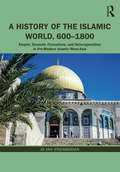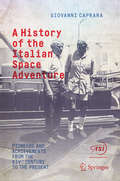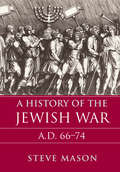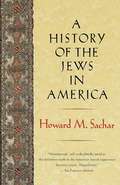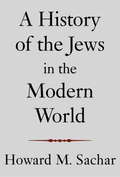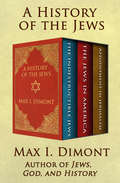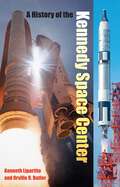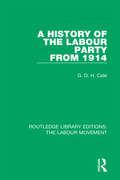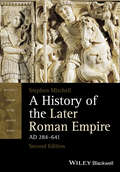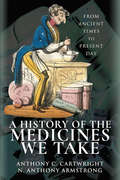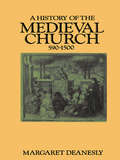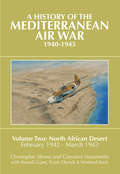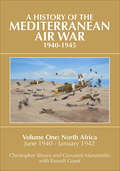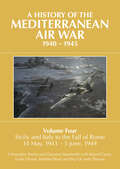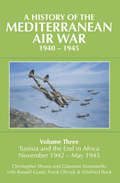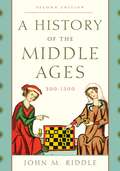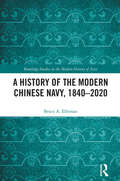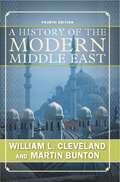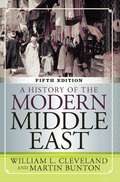- Table View
- List View
A History of the Islamic World, 600-1800: Empire, Dynastic Formations, and Heterogeneities in Pre-Modern Islamic West-Asia
by Jo Van SteenbergenA History of the Islamic World, 600–1800 supplies a fresh and unique survey of the formation of the Islamic world and the key developments that characterize this broad region’s history from late antiquity up to the beginning of the modern era. Containing two chronological parts and fourteen chapters, this impressive overview explains how different tides in Islamic history washed ashore diverse sets of leadership groups, multiple practices of power and authority, and dynamic imperial and dynastic discourses in a theocratic age. A text that transcends many of today’s popular stereotypes of the premodern Islamic past, the volume takes a holistically and theoretically informed approach for understanding, interpreting, and teaching premodern history of Islamic West-Asia. Jo Van Steenbergen identifies the Asian connectedness of the sociocultural landscapes between the Nile in the southwest to the Bosporus in the northwest, and the Oxus (Amu Darya) and Jaxartes (Syr Darya) in the northeast to the Indus in the southeast. This abundantly illustrated book also offers maps and dynastic tables, enabling students to gain an informed understanding of this broad region of the world. This book is an essential text for undergraduate classes on Islamic History, Medieval and Early Modern History, Middle East Studies, and Religious History.
A History of the Israeli-Palestinian Conflict
by Mark TesslerMark Tessler's highly praised, comprehensive, and balanced history of the Israeli-Palestinian conflict from the earliest times to the present—updated through the first years of the 21st century—provides a constructive framework for understanding recent developments and assessing the prospects for future peace. Drawing upon a wide array of documents and on research by Palestinians, Israelis, and others, Tessler assesses the conflict on both the Israelis' and the Palestinians' terms. New chapters in this expanded edition elucidate the Oslo peace process, including the reasons for its failure, and the political dynamics in Israel, the West Bank, and Gaza at a critical time of transition.
A History of the Italian Space Adventure: Pioneers and Achievements from the XIVth Century to the Present
by Giovanni CapraraThis well-documented and fascinating book tells how, over the centuries, a series of visionaries, scientists, technologists, and politicians fostered the involvement of Italy in space exploration. The lives of these pioneers was often far from easy, yet they persevered. The fruits of their efforts can today be witnessed in Italy’s success within the cutting-edge space sector. Italy’s history in space started at the end of the fourteenth century and continued with the development of fireworks. Later, the nineteenth century marked the beginning of research into rockets in a more scientific way. After World War II, rocket technology was advanced with the aid of German scientists, and in the 1960s Luigi Broglio, the father of Italian space exploration, designed the San Marco satellite. In 1979 the first Italian Space Plan was launched, but it was the foundation of the Italian Space Agency in 1988 that kick-started a program of exploration in various fields of cosmic research. The outcome was construction of the Vega launcher and collaboration in the International Space Station. Now the Italian space industry stands ready to play an important role in the Gateway orbital station. All of this history, and more, is explored in this riveting book.
A History of the Jewish People
by H. H. Ben-SassonThis textbook provides an overview of Jewish history beginning in ancient times, and Bible students will find these parts of this book to be an extremely useful reference. The book features pieces by several dozen authors, each with a unique perspective and expertise in the historical time being presented.
A History of the Jewish War: Ad 66–74
by Steve MasonA conflict that erupted between Roman legions and some Judaeans in late AD 66 had an incalculable impact on Rome's physical appearance and imperial governance; on ancient Jews bereft of their mother-city and temple; and on early Christian fortunes. Historical scholarship and cinema alike tend to see the conflict as the culmination of long Jewish resistance to Roman oppression. In this volume, Steven Mason re-examines the war in all relevant contexts (such as the Parthian dimension, and Judaea's place in Roman Syria) and phases, from the Hasmoneans to the fall of Masada. Mason approaches each topic as a historical investigation, clarifying problems that need to be solved, understanding the available evidence, and considering scenarios that might explain the evidence. The simplest reconstructions make the conflict more humanly intelligible while casting doubt on received knowledge.
A History of the Jews in America
by Howard M. SacharSpanning 350 years of Jewish experience in this country, A History of the Jews in America is an essential chronicle by the author of The Course of Modern Jewish History.With impressive scholarship and a riveting sense of detail, Howard M. Sachar tells the stories of Spanish marranos and Russian refugees, of aristocrats and threadbare social revolutionaries, of philanthropists and Hollywood moguls. At the same time, he elucidates the grand themes of the Jewish encounter with America, from the bigotry of a Christian majority to the tensions among Jews of different origins and beliefs, and from the struggle for acceptance to the ambivalence of assimilation.
A History of the Jews in the Modern World
by Howard M. SacharHistorian Sachar writes of the history of the Jews over the past 400 years, from Western Europe's 17th century age of mercantilism, to the 21st century struggle for Soviet Jewry. While he addresses the rise of Zionism and the birth of the State of Israel, he does not provide a comprehensive examination of the independent nation, explaining that it deserves its own separate treatment. He includes less common subjects such as the Sephardic-Oriental diaspora, and the Jews of Africa and of Moslem regions, and concludes with a prognosis for the 21st century. Annotation ©2005 Book News, Inc. , Portland, OR (booknews. com)
A History of the Jews: The Indestructible Jews, The Jews in America, and Appointment in Jerusalem
by Max I. DimontThree books on Jewish heritage from the author of Jews, God, and History, &“the best popular history of the Jews written in the English language&” (Los Angeles Times). With over a million and a half copies sold, Jews, God and History introduced readers to &“the fascinating reasoning&” of acclaimed scholar Max I. Dimont&’s &“bright and unorthodox mind&” (San Francisco Sunday Examiner and Chronicle). In these three volumes, Dimont builds on the themes and insights presented in that seminal work, providing a rich and comprehensive portrait of the cultural and religious history of the Jewish people. The Indestructible Jews traces the four-thousand-year journey of the Jewish people from an ancient tribe with a simple faith to a global religion with adherents in every nation. Through countless expulsions and migrations, the great tragedy of the Holocaust and the joy of founding a homeland in Israel, this compelling history evokes a proud heritage while offering a hopeful vision of the future. The Jews in America offers an overview of Judaism in the United States from colonial times to twentieth-century Zionism. Dimont follows the various waves of immigration, recounts the cultural achievements of those who escaped oppression in their native lands, and discusses the attitudes of American Jews—both religious and secular—toward Israel. Appointment in Jerusalem explores the mystery surrounding the predictions Jesus made about his fate. Dimont re-creates the drama in three acts using his knowledge of the events recorded in the Bible. Thoughtful and fascinating, his account offers fresh insights into questions that have surrounded religion for centuries. Who was Jesus—the Christian messiah or a member of a Jewish sect?
A History of the Kennedy Space Center
by Kenneth Lipartito Orville R ButlerThis first comprehensive history of the Kennedy Space Center, NASA's famous launch facility located at Cape Canaveral, Florida, reveals the vital but largely unknown work that takes place before the rocket is lit. Though the famous Vehicle Assembly Building and launch pads dominate the flat Florida landscape at Cape Canaveral and attract 1.5 million people each year to its visitor complex, few members of the public are privy to what goes on there beyond the final outcome of the flaring rocket as it lifts into space. With unprecedented access to a wide variety of sources, including the KSC archives, other NASA centers, the National Archives, and individual and group interviews and collections, Lipartito and Butler explore how the methods and technology for preparing, testing, and launching spacecraft have evolved over the last 45 years. Their story includes the Mercury and Gemini missions, the Apollo lunar program, the Space Shuttle, scientific missions and robotic spacecraft, and the International Space Station, as well as the tragic accidents of Challenger and Columbia. Throughout, the authors reveal the unique culture of the people who work at KSC and make Kennedy distinct from other parts of NASA.
A History of the Kitchen
by David EveleighWhat were early kitchens like? How have they evolved over time? What factors have influenced their design? David Eveleigh takes you into the heart of the home and shows us why modern kitchens are the way they are. Everything you could wish to know about kitchens and their unusual history will be found with these pages.
A History of the Labour Party from 1914 (Routledge Library Editions: The Labour Movement #5)
by G. D. ColeFirst published in 1948, this book gives a full account of the development of the British Labour Party from its emergence as a national influence in the first world war to its return to power with an effective majority after the second world war. The study includes an epilogue which surveys the achievements of the party in the years after the 1945 election. This title will be of interest to scholars and students of history and politics.
A History of the Later Roman Empire, AD 284-641
by Stephen MitchellThe Second Edition of A History of the Later Roman Empire features extensive revisions and updates to the highly-acclaimed, sweeping historical survey of the Roman Empire from the accession of Diocletian in AD 284 to the death of Heraclius in 641. <P><P> * Features a revised narrative of the political history that shaped the late Roman Empire<P> * Includes extensive changes to the chapters on regional history, especially those relating to Asia Minor and Egypt<P> * Offers a renewed evaluation of the decline of the empire in the later sixth and seventh centuries<P> * Places a larger emphasis on the military deficiencies, collapse of state finances, and role of bubonic plague throughout the Europe in Rome’s decline<P> * Includes systematic updates to the bibliography
A History of the Later Roman Empire, AD 284-700: The Transformation Of The Ancient World (Blackwell History of the Ancient World)
by Stephen Mitchell Geoffrey GreatrexA sweeping historical account of the Later Roman Empire incorporating the latest scholarly research In the newly revised 3rd edition of A History of the Later Roman Empire, 284-700, distinguished historians Geoffrey Greatrex and Stephen Mitchell deliver a thoroughly up-to-date discussion of the Later Roman Empire. It includes tables of information, numerous illustrations, maps, and chronological overviews. As the only single volume covering Late Antiquity and the early Islamic period, the book is designed as a comprehensive historical handbook covering the entire span between the Roman Empire to the Islamic conquests. The third edition is a significant expansion of the second edition—published in 2015—and includes two new chapters covering the seventh century. The rest of the work has been updated and revised, providing readers with a sweeping historical survey of the struggles, triumphs, and disasters of the Roman Empire, from the accession of the emperor Diocletian in AD 284 to the closing years of the seventh century. It also offers: A thorough description of the massive political and military transformations in Rome’s western and eastern empires Comprehensive explorations of the latest research on the Later Roman Empire Practical discussions of the tumultuous period ushered in by the Arab conquests Extensive updates, revisions, and corrections of the second editionPerfect for undergraduate and postgraduate students of ancient, medieval, early European, and Near Eastern history, A History of the Later Roman Empire, 284-700 will also benefit lay readers with an interest in the relevant historical period and students taking a survey course involving the late Roman Empire.
A History of the Medicines We Take: From Ancient Times to Present Day
by Anthony C. Cartwright N Anthony ArmstrongA fascinating account of poultices, pills, and prescriptions over the centuries and how they’ve been developed and delivered.This lively account follows the development of medicines from traces of herbs found with the remains of Neanderthal man, to prescriptions written on clay tablets from Mesopotamia in the third millennium BC, to pure drugs extracted from plants in the nineteenth century, and to the latest biotechnology antibody products. In addition, it tells the stories behind historical figures in medicine, such as Christopher Wren, who gave the first intravenous injection in 1656, and William Brockedon, who invented the tablet in 1843, as well as recounting the changes in patterns of prescribing from simple dosage forms—such as liquid mixtures, pills, ointments, lotions, poultices, powders for treating wounds, inhalations, eye drops, enemas, pessaries, and suppositories mentioned in the Egyptian Ebers papyrus of 1550 BCE—to the complex tablets, injections, and inhalers in current use. A typical pharmacy now dispenses about as many prescriptions in a working day as a mid-nineteenth-century chemist did in a whole year. This history sheds light on the scientific progress made over centuries that led to the medical miracles of the modern world.
A History of the Medieval Church: 590-1500
by Margaret DeaneslyFirst published in 1969. Routledge is an imprint of Taylor & Francis, an informa company.
A History of the Mediterranean Air War, 1940–1945. Volume 2: North African Desert, February 1942–March 1943
by Christopher Shores Giovanni Massimello Russell Guest Frank Olynyk Winfried BockThis second volume in the seminal series on aerial combat, pilots, and tactics in Libya and Egypt in the middle of World War II. In volume two of this series, historian Christopher Shores begins by exploring the 8th Army&’s movements after Operation Crusader when they were forced back to the Gazala area in northeastern Libya, as well as their defeat in June, 1942, the loss of Tobruk, and the efforts of Allied air forces to protect their retreating troops. Shores continues with the heavy fighting that followed in the El Alamein region. This features the Western Desert Air Force and the arrival of the first Spitfires. The buildup of both army and air forces and the addition of new commanders on the ground aided the defeat of Rommel&’s Deutsche Afrika Korps at Alam el Halfa, after which came the Second Battle of El Alamein. With the arrival of the United States Army Air Force, the Allied air forces gained dominance over the Axis. Shores recounts the lengthy pursuit of the Italo-German forces right across Libya, including the capture of Tripoli and the breakthrough into Southern Tunisia. This allowed a linkup with other Allied forces in Tunisia (whose story appears in Volume 3). Included with the action are stories of some of the great fighter aces of the Desert campaign such as Jochen Marseille and Otto Schulz of the Luftwaffe, Franco Bordoni-Bisleri of the Regia Aeronautica and Neville Duke, Billy Drake, and &“Eddie&” Edwards of the Commonwealth air forces. Finally, Shores touches on the Allied and Axis night bombing offensives and the activities of the squadrons cooperating with the naval forces in the Mediterranean.
A History of the Mediterranean Air War, 1940–1945: North Africa
by Christopher Shores Giovanni Massimello Russell GuestThis first volume in the seminal series on World War II aerial combat, pilots, and tactics that “reads like an encyclopedia on the subject” (Portland Book Review). In the early days of World War II, both Allied and Axis powers extended the theater of war to North Africa, where hard-fought battles were conducted in the harsh desert. But before anyone could claim victory on the ground, they had to hold dominion in the air. Here, historian Christopher Shores has combined his books Fighters over the Desert and Fighters over Tunisia into one volume, as well as adding updated information about the deadly fighter aircraft, reconnaissance aircraft, and maritime units active in the Mediterranean. Full of in-depth research and featuring essential maps, this is “an intimate introspection by these men of their experiences and the respect that they shared not only for each other but also their adversaries” (The Military Reviewer).
A History of the Mediterranean Air War, 1940–1945: Sicily and Italy to the Fall of Rome 14 May, 1943–5 June, 1944
by Christopher Shores Giovanni Massimello Russell Guest Frank Olynyk Winfried Bock Commander Andy ThomasThe fourth volume in this momentous series commences with the attacks on the Italian island fortress of Pantellaria which led to its surrender and occupation achieved almost by air attack alone. The account continues with the ultimately successful, but at times very hard fought, invasions of Sicily and southern Italy as burgeoning Allied air power, now with full US involvement, increasingly dominated the skies overhead. The successive occupations of Sardinia and Corsica are also covered in detail. This volume, then, is essentially the story of the tactical air forces up to the point when Rome was occupied, just at the same time as the Normandy landings were occurring in north-west France. In its pages are found what can justifiably be considered the story of ‘the soldiers’ air force’. Frequently overlooked by more immediate newsworthy events elsewhere, their struggle was often of an equally Homeric nature. With regards to the long-range tactical role of the Allied heavy bombers, only the period from May to October is examined herein, while they remained based in North Africa. Thus the period from November 1943 when the US 15th Air Force was formed to pursue the strategic air offensive against the Reich, together with the RAF’s 205 Group of night bombers, will be covered in a future (sixth) volume. Volume Five will deal with the rest of the tactical war in Italy and Greece, over the Adriatic and Aegean, and with the entry into the South of France to join forces advancing southwards from Normandy.
A History of the Mediterranean Air War, 1940–1945: Tunisia and the End in Africa, November 1942–1943 (A\history Of The Mediterranean Air War, 1940-1945 Ser. #2)
by Christopher Shores Giovanni Massimello Russell Guest Frank OlynykThe third volume in the epic military aviation series focuses on the Allied invasion of North Africa during World War II. This work of WWII history takes us to November 1942 to explain the background of the first major Anglo-American venture: Operation Torch, the invasion of French North Africa. Describing the fratricidal combat that followed the initial landings in Morocco and Algeria, it then considers the unsuccessful efforts to reach northern Tunisia before the Germans and Italians could get there to forestall the possibility of an attack from the west on the rear of the Afrika Korps forces, then beginning their retreat from El Alamein. The six months of hard fighting that followed, as the Allies built up the strength of their joint air forces and gradually wrested control of the skies from the Axis, are recounted in detail. The continuing story of the Western Desert Air Force is told, as it advanced from the east to join hands with the units in the west. Also covered are the arrivals over the front of American pilots and crew, the P-38 Lightning, the Spitfire IX, and the B-17 Flying Fortress—and of the much-feared Focke-Wulf Fw 190. The aerial activities over Tunisia became one of the focal turning points of World War II, yet are frequently overlooked by historians. Here, the air-sea activities, the reconnaissance flights, and the growing day and night bomber offensives are examined in detail.
A History of the Middle Ages, 300–1500
by John Riddle Winston Black<p>This clear and comprehensive text covers the Middle Ages from the classical era to the late medieval period. Distinguished historian John Riddle provides a cogent analysis of the rulers, wars, and events—both natural and human—that defined the medieval era. Taking a broad geographical perspective, Riddle includes northern and eastern Europe, Byzantine civilization, and the Islamic states. Each, he convincingly shows, offered values and institutions—religious devotion, toleration and intolerance, laws, ways of thinking, and changing roles of women—that presaged modernity. In addition to traditional topics of pen, sword, and word, the author explores other driving forces such as science, religion, and technology in ways that previous textbooks have not. He also examines such often-overlooked issues as medieval gender roles and medicine and seminal events such as the crusades from the vantage point of both Muslims and eastern and western Christians. <p>In addition to a thorough chronological narrative, the text offers humanizing features to engage students. Each chapter opens with a theme-setting vignette about the lives of ordinary and extraordinary people. The book also introduces students to key controversies and themes in historiography by featuring in each chapter a prominent medieval historian and how his or her ideas have shaped contemporary thinking about the Middle Ages. Richly illustrated with color plates, this lively, engaging book will immerse readers in the medieval world, an era that shaped the foundation for the modern world.</p>
A History of the Middle East: Fifth Edition
by Peter Mansfield Nicolas PelhamThe definitive history of the Middle East, thoroughly revised and updated through 2012 One of the most crucial, volatile, and complex regions of the modern world, the Middle East has long confounded the dreams of conquerors and peacemakers alike. This now-classic book, fully updated to 2012 and still the essential work on the subject, follows the historic struggles of the Middle East from Napoleon's campaign in Egypt and Syria, through the slow decline and fall of the Ottoman Empire, to the Israeli-Palestinian conflict and the history of Islam and its recent resurgence. For this fourth edition, Economist correspondent Nicolas Pelham contributes an extensive new section examining recent developments throughout the Middle East, including the invasions of Iraq and Afghanistan, the situation in Iran, the region's relations with the United States under President Obama, the Arab Spring, and more.
A History of the Modern Chinese Navy, 1840–2020 (Routledge Studies in the Modern History of Asia)
by Bruce A. EllemanThis book provides a comprehensive history of the modern Chinese navy from 1840 to the present. Beginning with a survey of naval developments in earlier imperial times, the book goes on to show how China has since the mid-19th century four times built or rebuilt its navy: after the Opium Wars, a navy which was sunk or captured by the Japanese in the war of 1894–1895; during the 1920s and 1930s, a navy again sunk or lost to Japan, in the war of 1937–1945; in the 1950s, a navy built with Soviet help, which stagnated following the Sino-Soviet split in the early 1960s; and finally the present navy which absorbed its predecessor, but with the most modern sections dating from the 1990s—a navy which continues to grow and prosper. The book also shows how the underlying strategic imperative for the Chinese navy has been the defense of China’s coasts and major rivers; how naval mutiny was a key factor in the overthrow of the Qing and the Nationalist regimes; and how successive Chinese governments, aware of the potent threat of naval mutiny, have restricted the growth, independence, and capabilities of the navy. Overall, the book provides—at a time when many people in the West view China and its navy as a threat—a rich, detailed, and realistic assessment of the true nature of the Chinese navy and the contemporary factors that affect its development.
A History of the Modern Church: From 1500 to the Present Day (Routledge Revivals)
by J. W. WandFirst published in 1930, A History of the Modern Church is a scholarly and readable account of the church from the beginning of the Reformation to modern times. It traces the rise of many attitudes towards life, many conceptions of the faith, and many ecclesiastical systems. This book will be of interest to students of religion and history.
A History of the Modern Middle East
by ClevelandThis comprehensive work provides a penetrating analysis of modern Middle Eastern history, from the Ottoman and Egyptian reforms, through the challenge of Western imperialism, to the Iranian Revolution and the recent Gulf War. <P><P> After introducing the reader to the region's history from the origins of Islam in the seventh century, Cleveland focuses on the past two centuries of profound and often dramatic change. While built around a framework of political history, the book also carefully integrates social, cultural, and economic developments into a single, carefully crafted account. Cleveland sets the stage with a superb, concise overview of the long-term, general patterns of Middle Eastern history. The book opens with a portrayal of Islam that stresses an understanding of this great world religion and culture on its own terms and in its specific historical setting. The rich potential of this culture manifested itself in shifting centers of Islamic florescence, culminating in the rise of the Ottoman and Safavid Empires as the central political and social entities of the Middle East in the sixteenth through the eighteenth centuries. The book next examines the crucial developments of the nineteenth century-an era characterized by attempts at the self-transformation of Middle Eastern societies, a process sometimes misleadingly referred to as "modernization" or "Westernization. " The resulting disruption of the established order was a wrenching and disorienting experience for the peoples of the region. Defeat in World War I delivered the coup de grace to Ottoman rule and brought in the "mandate system" through which the British and the French sought to impose their overlordship on the Arab world. The interwar years, through to the end of World War II, were characterized by the Arab struggle for independence. This struggle led to the emergence of the major political ideologies of the Arab world-regionalism, pan-Arab nationalism-combined with the enduring appeal of Islamic solidarity. During this same period the two major independent states of the region, Turkey and Iran, embarked on intensive programs of secular reform designed to remake their societies in the image of the West. Several Arab states were able to establish their independence, but this process was greatly complicated by the legacies of European rule, especially the founding of the state of Israel in 1948 and the cold war rivalry of the superpowers. Many of the problems faced in the region today are a direct consequence of this historical legacy: the Arab-Israeli conflict, the concentration of oil wealth into the hands of a few, the Iran-Iraq war, the Palestinian problem, the dissolution of Lebanon, Islamic fundamentalism, and the striving for power on the world stage of states such as Syria, Iraq, and Iran. A History of the Modern Middle East explains the deep historical currents flowing beneath today's headlines, making it essential reading for anyone seeking a better understanding of today's turbulent world.
A History of the Modern Middle East
by Martin Bunton William L ClevelandThis comprehensive work provides a penetrating analysis of modern Middle Eastern history, from the Ottoman and Egyptian reforms, through the challenge of Western imperialism, to the impact of US foreign policies. After introducing the reader to the region's history from the origins of Islam in the seventh century, A History of the Modern Middle East focuses on the past two centuries of profound and often dramatic change. Although built around a framework of political history, the book also carefully integrates social, cultural, and economic developments into a single, expertly crafted account. In updating this fifth edition of the late William Cleveland's popular introductory text, Martin Bunton provides a thorough account of the major transformative developments over the past four years, including a new chapter on the tumultuous Arab uprisings and the participation of Islamist parties in a new political order in the Middle East.
